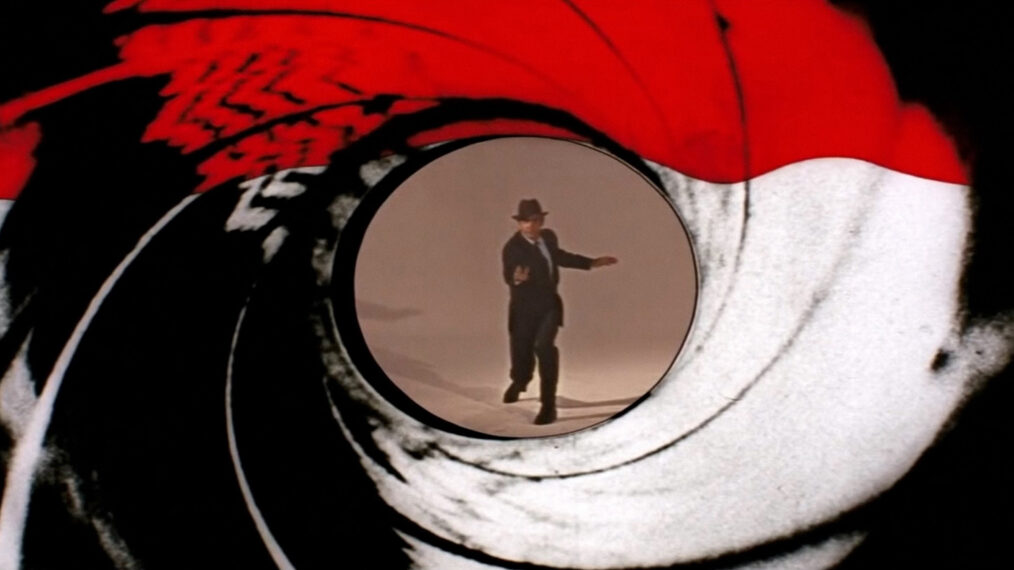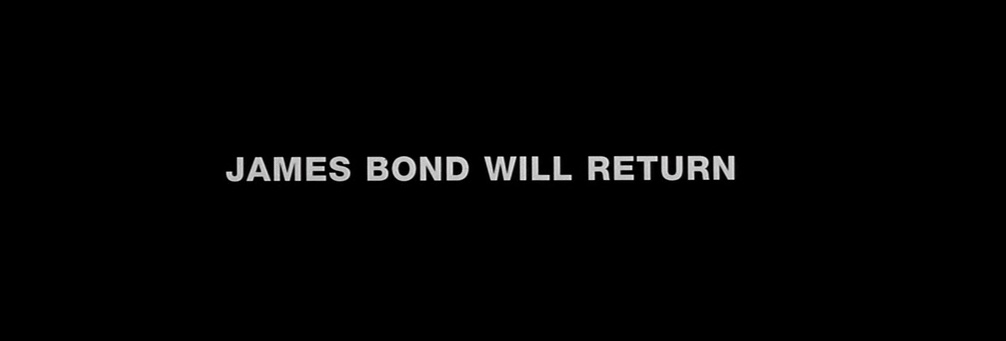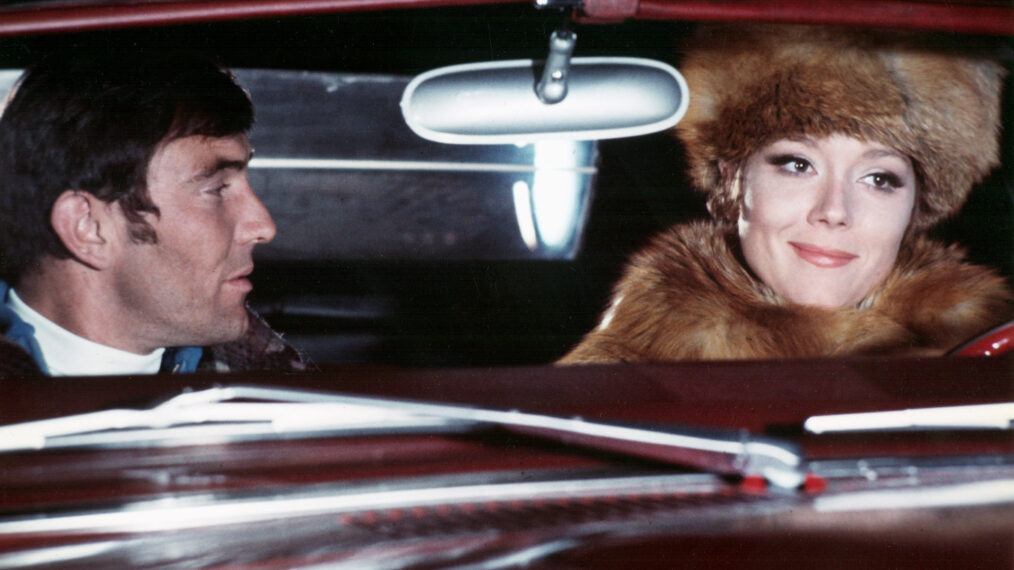Pluto TV’s James Bond Channel Has Returned

UPDATED 1/1/25: As of Jan. 1, 2025, the James Bond 007 Channel is once again no longer available on Pluto TV. We’ll update if the channel returns in the future.
Most of the James Bond movies have famously featured a line in their closing credits, promising that “James Bond Will Return” in a new film, like the message featured at the end of 1999’s The World Is Not Enough pictured below.

© United Artists/Screenshot from bondmovies.com
Fans of 007 will be happy to learn about another terrific return related to the famed fictional secret agent — Pluto TV‘s channel devoted to Bond films 24/7 is back!
Apparently the channel, called “Pluto TV 007,” was around for a while during the early days of the COVID pandemic, then went away. But it came back starting at the beginning of November 2024. Not sure if this stay is also temporary, but it’s worth enjoying while you can.
Pluto TV 007 features 20 of the 25 official Bond movies produced by Eon (so you won’t see 1983’s Never Say Never Again or the 1967 Casino Royale, which are non-canon with the official series).
The only films that I’ve noticed are not included on Pluto TV 007 at this point are the Sean Connery-led titles From Russia With Love (1963) and Goldfinger (1964), and the Daniel Craig titles Casino Royale (2006), Skyfall (2012) and Spectre (2015). I’m not sure of the reasoning for this (probably some sort of licensing issue), or if these titles will be added at some point.
But there is still plenty of Bond action to enjoy on the channel, including the other four Connery films, Craig’s other two films, and all of the films led by Roger Moore, Timothy Dalton, Pierce Brosnan and George Lazenby.
BOND MOVIES FEATURED ON PLUTO TV’s 007 CHANNEL
Dr. No (1962)
The one that started it all, featuring Connery’s Bond up against Joseph Wiseman as the title villain, and joined by original Bond girl Ursula Andress as Honey Ryder.
And also including this iconic first intro:
Thunderball (1965)
Bond’s in the Bahamas, trying to locate a nuclear warhead stolen by SPECTRE. This was the first entry to feature underwater scenes, which were directed by famed stuntman/actor Ricou Browning, who had earlier portrayed the Gill-man for the underwater sequences in Creature From the Black Lagoon (1954).
And, of course, there was the bombastic title theme song performed by Tom Jones.
You Only Live Twice (1967)
Bond tries to foil another SPECTRE plot, this time in Japan. This film, with its screenplay by Roald Dahl, is where the franchise really started deviating pretty wildly from Ian Fleming’s novels, but certainly in a fun way. It’s also where we see the face of SPECTRE leader Ernst Stavro Blofeld for the first time, played here by Donald Pleasence.
And it boasts one of the series’ loveliest title themes, with music by longtime franchise composer John Barry and lyrics by Leslie Bricusse, and performed by Nancy Sinatra.
On Her Majesty’s Secret Service (1969)
George Lazenby stepped into Bond’s shoes for his one and only time in this film that is actually very good. It is certainly helped by Diana Rigg as Tracy, the one “Bond girl” whom Bond fell in love with enough to marry, and Telly Savalas as Blofeld.
You can read more about OHMSS here:
Diamonds Are Forever (1971)
Connery was talked into (with a then-unprecedented $1.25 million salary offer doing most of the speaking) returning as Bond for his last time in the official franchise in what is frankly one of his weaker efforts. It does have its moments, though, as Bond goes from Holland to Las Vegas tracing stolen diamonds that eventually lead back to yet another sinister plot by Blofeld (played here by Charles Gray).
The film does have another great title tune performed by the iconic Dame Shirley Bassey, her second time performing a Bond song after Goldfinger, with music by Barry and lyrics by Don Black:
Live and Let Die (1973)
The Roger Moore era of Bond films, which were often tongue-in-cheek if not outright silly fun at times, began with this effort costarring Yaphet Kotto and Jane Seymour.
Also of note is its Oscar-nominated title tune, written by Paul and Linda McCartney and performed by their band, Wings, which was the first rock song to open a Bond movie:
The Man With the Golden Gun (1974)
Bond is in the Far East and up against Christopher Lee‘s Francisco Scaramanga, the deadly assassin of the title. Britt Ekland and Hervé Villechaize costar, along with Maud Adams as a “secondary Bond girl”; Adams would return as the main Bond girl nine years later in Octopussy.
The Spy Who Loved Me (1977)
One of the most memorable films of Moore’s tenure as Bond, this one found 007 teaming with Barbara Bach as Russian agent Triple X and introduced Richard Kiel as Jaws, one of the more famous henchmen from the franchise. Playing one of the henchwomen is the lovely Caroline Munro (as one of of my earliest pretend celebrity girlfriends, I have to give Caroline a shout-out).
Marvin Hamlisch received an Oscar nomination for his sometimes disco-fied score (hey, it was the late ’70s, but his “Bond ’77” track is genuinely a lot of fun to listen to). The opening song, “Nobody Does It Better,” featuring music by Hamlisch and lyrics by Carole Bayer Sager, and performed by Carly Simon, also received an Oscar nod:
Moonraker (1979)
Obviously influenced by the success of Star Wars a couple of years earlier, this title actually takes Bond into outer space (courtesy of Oscar-nominated special effects), following stops on Earth in Italy and South America.
It’s one of the sillier but still fun Moore entries, and boasts not only one of the franchise’s best pre-title sequences — with Bond getting pushed out of a plane without a parachute — but also one of the more ridiculously named “Bond girls”: Dr. Holly Goodhead (Lois Chiles).
And Dame Shirley Bassey, who is always worth listening to, was back to perform another lovely title tune. You can hear it, following the aforementioned pre-title sequence, here:
For Your Eyes Only (1981)
For a Moore title, this is a relatively straight-forward spy thriller, a nice refresher after the craziness of Moonraker. That’s not to say there are not silly moments, of course, most notably the somewhat uncomfortable scenes where former figure skater Lynn-Holly Johnson (who more famously led 1978’s Ice Castles), playing a very young Olympic hopeful, comes on to Moore’s very much older Bond.
She’s not the main Bond girl, fortunately; that honor falls to Carole Bouquet as Melina Havelock. Also starring are Topol as Bond ally Columbo, and Julian Glover (who played Walter Donovan, the main bad guy in Indiana Jones and the Last Crusade, and Imperial General Veers in The Empire Strikes Back) as the “big bad,” Kristatos.
This film’s Oscar-nominated title song is at or near the top of my favorite Bond theme songs. With music by Bill Conti and lyrics by Michael Leeson, it is very lovely, especially as performed by Sheena Easton, one of my ’80s crushes.
Ms. Easton is so beautiful that, as far as I’ve been able to determine, she is the only artist who has so far been also featured visually during the opening credits as she sings her Bond tune:
Octopussy (1983)
Roger Moore probably should have ended his Bond stint with this rip-roaring adventure that takes us from India to East and West Germany in a plot involving a crazy Soviet general (Steven Berkoff, who would go on to play the bad guy in Beverly Hills Cop the following year) who wants to nuke a NATO airbase.
Maud Adams costars as the title Bond girl, with Gigi star Louis Jourdan acquitting himself nicely as a primary bad guy.
Rita Coolidge performed the title tune, “All Time High” (one of the few Bond themes to not mention the movie’s title), which stayed at No. 1 on Billboard’s Adult Contemporary singles chart for four weeks:
A View to a Kill (1985)
This entry, Moore’s last outing as 007, is pretty hit-or-miss for me, but it does have sentimental value for me as it was the first Bond movie that I saw at the theater during its initial release.
Christopher Walken is cool as the main bad guy, a Nazi-engineered psycho plotting to destroy Silicon Valley. Grace Jones costars, as does Tanya Roberts, who I’ve found to be among the weaker Bond girls (it doesn’t help that she was nearly 30 years Moore’s junior).
The hit title song, written by John Barry and rock group Duran Duran, who also performed the tune, brought Bond music into the ’80s, incorporating electronic elements for the first time.
You can hear the song in the video below following the pre-title sequence, where Bond also happens to casually bring the sport of snowboarding into popular consciousness (accompanied by the Beach Boys‘ “California Girls”) as he flees Soviet soldiers in snowy Siberia:
The Living Daylights (1987)
I remember reading a newspaper article sometime in 1986 about the casting of a new actor to play James Bond after Roger Moore had ended his tenure, an actor named Timothy Dalton. The name meant nothing to me at the time, but since seeing him as 007 in this first outing, I really admire his portrayal. It is a fairly intense and serious performance, yet punctuated with bits of wry humor, almost a precursor to Daniel Craig’s era, in a film that marked the last time that Soviets factored as villains in a James Bond movie.
Perhaps audiences at the time were not ready for Dalton’s Bond, but I enjoyed it. The plot in his first feature is great, more old-school espionage stuff versus a madman intent on world domination, and it’s all enhanced by John Barry’s final score for a Bond movie, which is one of his best.
That includes the title tune, which Barry cowrote with pop group a-ha. You can see and hear it in these two videos below, which also include the fantastic pre-title sequence that introduces Dalton as Bond:
For The Living Daylights, Barry also cowrote “Where Has Everybody Gone?” with Chrissie Hynde of the Pretenders, and the band performed it. It is heard in the film when the assassin Necros attacks, and Barry incorporated instrumental elements of the tune for scenes featuring Necros. It is also a great song with a terrific sound, a sound that could have lent itself to being the main opening theme:
Licence to Kill (1989)
Dalton’s second and last outing as Bond finds 007 on a personal vendetta against drug lord Franz Sanchez (Robert Davi), who murdered the new wife (played by Priscilla Barnes) of his CIA pal, Felix Leiter (David Hedison), and nearly killed Leiter himself. Benicio del Toro made his second feature film appearance as the memorable Dario, one of Sanchez’s henchmen.
I’m not sure some people liked this direction for Bond, but I appreciated the franchise trying something new, and I do enjoy the film. The opening theme is not as memorable as previous ones, though, despite being performed by the legendary Gladys Knight, so I’ll just post one of the cool action scenes from the movie:
GoldenEye (1995)
After an unprecedented six-year hiatus (old-schoolers like me will probably remember that for a long time up until that point, you could count on having a new Bond movie every two-to-three years), James Bond returned — in the form of new actor Pierce Brosnan (who was originally wanted for the role following Roger Moore, but couldn’t due to his commitment to the TV show Remington Steele).
Brosnan’s tenure in the role seems to be sort of a bridge between Dalton and Daniel Craig. He combines the funny and sexy elements of Sean Connery and Roger Moore with Dalton’s and Craig’s sometimes brooding intensity and seriousness, and his Bond films are quite enjoyable, especially his first one.
The first Bond movie to not use any elements from an Ian Fleming novel or short story, GoldenEye also features Sean Bean as the main bad guy, with a title tune written by Bono and the Edge, and performed by Tina Turner:
Tomorrow Never Dies (1997)
With its plot about a mad media mogul (played by Jonathan Pryce) who uses his newspapers and cable news network to try to start World War III, Tomorrow Never Dies may have been more prescient than people thought at the time.
Costarring Michelle Yeoh and Teri Hatcher, the film also features an intriguing and new setting for the franchise in Vietnam, and also boasts one of the better pre-title sequences in the series:
The World Is Not Enough (1999)
The motto on James Bond’s family’s coat of arms, mentioned in On Her Majesty’s Secret Service, serves as the title for this Brosnan entry. It also seems to be the ethos of the film’s main villain, which for the first time is a woman, played by Sophie Marceau.
Denise Richards costars as the ridiculously named nuclear scientist Dr. Christmas Jones, with Robert Carlyle on hand as a villainous henchman who can literally feel no pain. The film also marks the final appearance of Desmond Llewelyn as “Q,” the guy who provided 007 with all his cool gadgets, a role that would be taken on by John Cleese (introduced here as “R”). The title tune was composed by David Arnold, with lyrics by Don Black, and performed by rock band Garbage.
The World Is Not Enough also features the second-longest pre-title sequence in the franchise (after No Time to Die), running about 14 minutes It’s divided across two videos below (the second one also including the opening titles and theme song):
Die Another Day (2002)
Brosnan’s last outing as Bond came as the 20th entry in the franchise, and was released 40 years after the first movie, Dr. No. As such, it incorporates a lot of fun references to Bond history — some obvious, some more subtle — which adds to the fun of an already cool story that kicks off in North Korea, a new locale for the series.
Halle Berry costars as NSA agent Jinx, who teams with Bond, and she was originally slated to have her own spinoff film series, but those plans were canceled.
Madonna cowrote and performed the title tune, which added a dance-pop entry to the long history of Bond themes. It’s kind of cool and unique not only soundwise, but also because the titles continue the story started in the pre-title sequence, showing Bond being tortured while in North Korean captivity. Madonna also has a cameo as Verity, an instructor at the fencing club where Bond and the main villain, Gustav Graves (Toby Stephens), have a pretty violent sparring session.
Quantum of Solace (2008)
Daniel Craig’s second appearance as James Bond seems to be among the least-liked, from what I gather. It is certainly different style-wise from any other Bond film, but, again, I appreciate a long-running franchise trying something different. It does not always succeed, but I generally like it, and like a lot of Craig’s entries, it might be one of the closest to Ian Fleming’s original vision of James Bond.
Among its most notable differences from other movies, Quantum of Solace is one of the shorter Bond films, running just one hour, 46 minutes; it is quick and brutal, like Bond himself. It also features a unique location for the franchise: Bolivia.
Jack White and Alicia Keys collaborated on the title tune, “Another Way to Die,” the first duet for a Bond theme song. I wasn’t particularly impressed with it, so I’ll just post one of the memorable action sequences from the film:
Skyfall (2012) (Dec. 10, 2024, update)
Well, as of early December 2024, it looks like Skyfall is now in Pluto TV ‘s library, contrary to what I saw when I first looked in November.
This will probably continue to be the case with Pluto’s 007 channel, similar to what I found with their Godzilla channel; some movie titles might come and go, often with little to no warning, based on licensing availability.
So enjoy Skyfall while you can. And it is one of the more enjoyable Craig-led Bond movies, featuring Javier Bardem as the main bad guy. There is a minor Bond girl near the beginning, but this film is interesting in that Judi Dench, in her final appearance as “M,” is kind of the the main Bond girl.
The title song, written by Adele and producer Paul Epworth, and performed by Adele, received an Oscar nomination and kicks things off in a wonderful way:
No Time to Die (2021)
Craig’s swan song as Bond is a terrific way for him to go out. It completes the character’s cycle as depicted in this particular actor’s run, and it will be interesting to see how the franchise reboots with someone else.
One of the standout sequences here is when Bond and CIA agent Paloma (played by Ana de Armas, who also costarred with Craig in the original Knives Out) infiltrate a SPECTRE gathering in Cuba (by the way, it’s been great to see SPECTRE and Blofeld, played here by Christoph Waltz, finally able to be brought back into the Bond franchise following decades of legal wrangling):
When I first tuned in to Pluto TV 007 a few weeks back, they were generally airing these titles in order of their release, but lately they’ve been airing more randomly. Which is fine (and you can watch them on demand, as well).
It’s just nice knowing that James Bond has returned.

